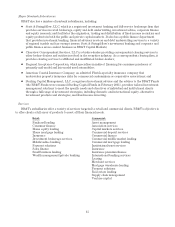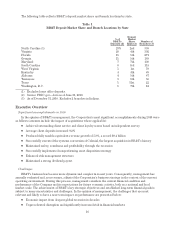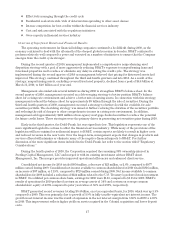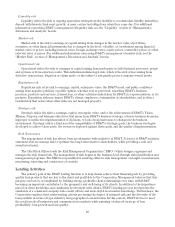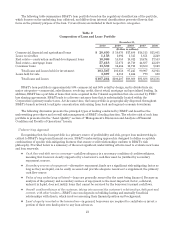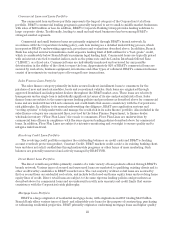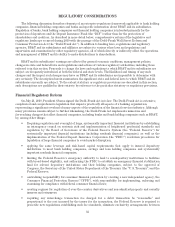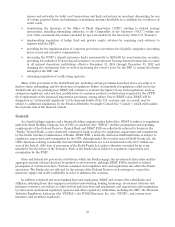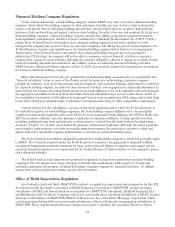BB&T 2010 Annual Report Download - page 25
Download and view the complete annual report
Please find page 25 of the 2010 BB&T annual report below. You can navigate through the pages in the report by either clicking on the pages listed below, or by using the keyword search tool below to find specific information within the annual report.
(Dollars in
millions)
(i) consumer loans $13,532
(ii) real estate mortgage loans 57,418
(iii) loans held for sale 3,697
(iv) lease receivables 1,158
Total $75,805
Scheduled repayments are reported in the maturity category in which the payment is due. Determinations of
maturities are based upon contract terms. In accordance with regulatory reporting standards, variable rate loans
that have reached a floor are reported as fixed-rate loans. BB&T’s credit policy typically does not permit
automatic renewal of loans. At the scheduled maturity date (including balloon payment date), the customer
generally must request a new loan to replace the matured loan and execute either a new note or note modification
with rate, terms and conditions negotiated at that time.
Allowance for Loan and Lease Losses and Reserve for Unfunded Lending Commitments
The allowance for loan and lease losses is determined based on management’s best estimate of probable
losses inherent in the portfolio at the balance sheet date. BB&T’s allowance is driven by existing conditions and
observations, and reflects losses already incurred, even if not yet identifiable.
The Corporation determines the allowance based on an ongoing evaluation of its loan and lease portfolios.
This evaluation is inherently subjective because it requires material estimates, including the amounts and timing
of cash flows expected to be received on impaired loans. Those estimates may be susceptible to significant change.
Increases to the allowance are made by charges to the provision for credit losses, which is reflected in the
Consolidated Statements of Income. Loans or leases deemed to be uncollectible are charged against the
allowance. Recoveries of previously charged-off amounts are credited to the allowance.
In addition to the allowance for loan and lease losses, BB&T also estimates probable losses related to binding
unfunded lending commitments. The methodology to determine such losses is inherently similar to the
methodology used in calculating the allowance for commercial loans, adjusted for factors specific to binding
commitments, including the probability of funding and exposure at funding. The reserve for unfunded lending
commitments is included in accounts payable and other liabilities on the Consolidated Balance Sheets. Changes to
the reserve for unfunded lending commitments are made by charges or credits to the provision for credit losses.
While management uses the best information available to establish the allowance for loan and lease losses,
future adjustments to the allowance or to the reserving methodology may be necessary if economic conditions
differ substantially from the assumptions used in making the valuations.
Reserve Policy and Methodology
BB&T has developed a systematic methodology to determine its allowance for loan and lease losses that
gives appropriate consideration to differences in the nature of its lending portfolio. A risk-based approach is used
to estimate the allowance related to the commercial lending portfolio, which consists of commercial real estate,
commercial and industrial (“C&I”) and certain specialized lending loans and leases. A delinquency-based approach
is used to estimate the allowance related to the retail lending portfolio, which consists of direct retail lending,
revolving credit, mortgage, sales finance and certain retail-oriented specialized lending loans. An expected cash
flows approach is used to estimate the allowance related to loans acquired subsequent to December 31, 2008.
A portion of the Corporation’s allowance for loan and lease losses is not allocated to any specific category of
loans. This unallocated portion of the allowance reflects management’s best estimate of the elements of
imprecision inherent in the calculation of the overall allowance. Due to the subjectivity involved in determining
the overall allowance, including the unallocated portion, the portion considered unallocated may fluctuate from
period to period based on management’s evaluation of the factors affecting the assumptions used in calculating
the allowance, including historical loss experience, current economic conditions, industry or borrower
concentrations and the status of merged institutions. The unallocated portion of the allowance is available to
absorb losses on any loan category or lending-related commitment. Management evaluates the adequacy of the
allowance for loan and lease losses based on the combined total of the allocated and unallocated components.
25


